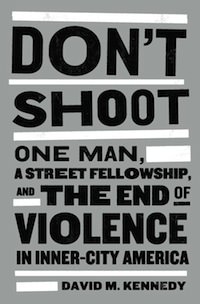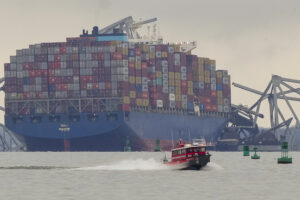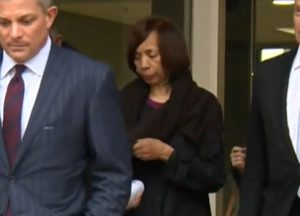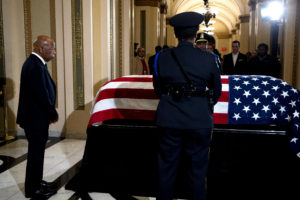Baltimore: The City That Bleeds
David Kennedy, author of "Don't Shoot: One Man, a Street Fellowship, and the End of Violence in Inner-City America," spent more than 10 years in the worst corners of the worst cities in the country before going to Baltimore.
Excerpted from “Don’t Shoot: One Man, a Street Fellowship, and the End of Violence in Inner-City America” by David M. Kennedy.
Baltimore came by way of a community nonprofit, the Safe and Sound Campaign. Safe and Sound — really its executive director, Hathaway Ferebee — has been the relentless leading voice on children’s issues in Baltimore for years. Hathaway is tiny, pixieish, burns with energy, her diamond basic goodness luminously self-evident. In Baltimore, she rolled her rocks uphill. Baltimore did not then figure in the public mind as one of America’s high-crime cities; that conversation ran to Chicago, L.A., Detroit, East St. Louis, sometimes the two Richmonds — Virginia and California — Newark. The Wire has changed that somewhat, as it should. Baltimore is consistently one of the most dangerous places in the country. It was one of the original, late-1960s heroin-epidemic cities; for some reason, it’s the only one where the epidemic didn’t burn itself out. Heroin is still going strong in Baltimore — her-ron, as it goes locally — and the city has the highest rate of injection drug use in the country. It was hit hard by the decline of the shipping industry that made it a thriving port city, by the decline of its manufacturing base, by both white and black flight, by the crack epidemic that stacked itself on top of the heroin epidemic. (In 1986, its goodwill flagship, the schooner Pride of Baltimore, went down at sea, which said about all that needed to be said.)
Baltimore’s Tiffany Moore was six-year-old, braided Tiffany Smith, shot in the head in 1991. A mistake, a shootout between drug-dealer rivals. She got the street corner where she was shot dead named after her: Tiffany Square. Four more people would be killed on the same corner over the next several years; it was a thriving heroin market when I hit town. Mayor Kurt Schmoke had started a branding campaign: “Baltimore: The City That Reads.” In 1993, with a population of around 730,000, the city had 353 homicides, six times New York City’s rate. What everybody said: “Baltimore: The City That Bleeds.” There were boiling open-air drug markets a skip and a jump from the trendy inner harbor. In its worst quarters, it’s Beirut.
When Hathaway came calling, I took it personally. My two sisters live in and just outside the city; my younger sister is a critical-care nurse at Johns Hopkins, which sits in one of the hottest parts of Baltimore. I would get calls when they heard about particularly awful things on the news. Why’d they do that? my youngest nephew said. Can’t you make them stop? I’ll try, I said.
Don’t Shoot: One Man, a Street Fellowship, and the End of Violence in Inner-City America
By David M. Kennedy
Bloomsbury USA, 320 pages
Anthony, research assistant Gillian Thomson, and I hit Baltimore in early 1998. By then I’d spent more than ten years in the worst corners of the worst cities in the country. Baltimore shocked even me. On my first ride with a Baltimore police officer, we turned down a corner and a block and a half up, in broad daylight, was a heroin dealer standing in full view on the sidewalk holding what looked like a gallon freezer bag full of vials, their orange caps blazing in the sun. Drug dealers respond and adapt to law enforcement, an intricate pas de deux; they slide off when the heat shows, take pains to separate their main stash from what they’re selling right that moment, separate the drugs and the money, use legally invulnerable juveniles to do the dirty work. This guy stood there watching us as we rolled up, by, past, never moved, never hid his dope. There must have been forty people in the twin lines standing in front of him waiting to get served, and they never moved either. Everything was amped up in Baltimore, the streets worse, the offenders more lost and pathetic, the law enforcement response particularly relentless and particularly pointless. Some time later I’d be out at night with a drug cop, turn down an alley, crawl through as a crowd of dealers fishbowled us from all sides. “Who’s winning?” the cop said cheerfully through his open window. One, heroically intoxicated, thought about it for a while. “We are,” he decided. He was right.
But Baltimore was what we, what I, wanted. It was the next step, what gunsmiths call the proof test: Fire a hot shot and if the gun survives the extreme heat and pressure, you know it won’t blow up in your face. If we could handle Baltimore, we could handle anything. Boston itself was still quiet, the streets looked great, there was hardly anything for the Ceasefire working group to do. It was still too early for the formal evaluations –Anne and Anthony wanted data through the end of 1998 — but the calm was holding. The homicide rate was still falling. Over in the Boston Police Department homicide squad, they were focusing on old, cold cases; there weren’t enough new ones to keep them busy. The Streetworkers were exultant. Things still happen, one of them told us, but they don’t spread like they used to, don’t turn into the beefs and the crazy vendettas, they just die out. “They never used to let us outside and stuff, because they was scared we were going to get shot or something,” a Boston kid told the Jim Lehrer NewsHour. “But now we can go outside and do anything we want most of the time ’cause there’s not other people here to do all the bad things.” Anne and Anthony and I were speculating about what we called “the firebreak hypothesis”: that if things were quiet enough, long enough, maybe the cycle of fear and violence and guns could be broken. Maybe quiet would beget quiet, just as violence had begotten violence. Maybe it would really be over. It did not seem out of reach.
Copyright ©2011 by David Kennedy Don’t Shoot: One Man, a Street Fellowship, and the End of Violence in Inner-City America by David Kennedy Reprinted by permission of Bloomsbury USA
Your support matters…Independent journalism is under threat and overshadowed by heavily funded mainstream media.
You can help level the playing field. Become a member.
Your tax-deductible contribution keeps us digging beneath the headlines to give you thought-provoking, investigative reporting and analysis that unearths what's really happening- without compromise.
Give today to support our courageous, independent journalists.






You need to be a supporter to comment.
There are currently no responses to this article.
Be the first to respond.